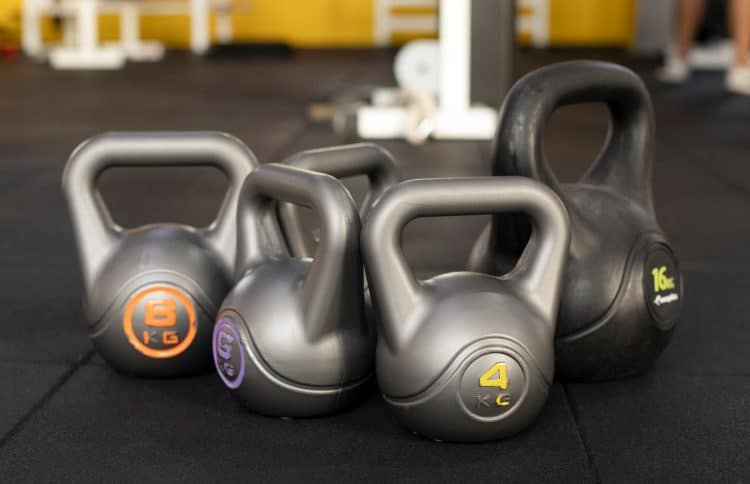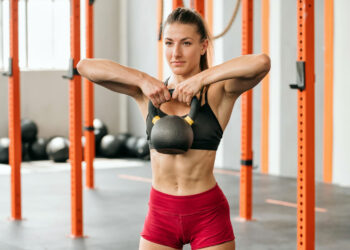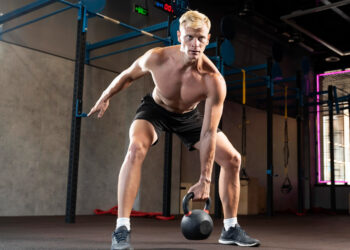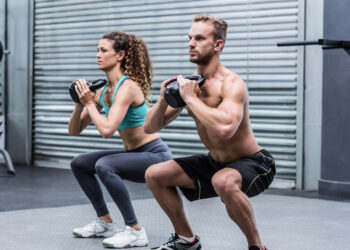Kettlebells have gained popularity in recent years. That’s hardly surprising due to their effectiveness in boosting cardiovascular and muscular strength and endurance. However, kettlebells can be pricey, which keeps many fitness enthusiasts from adding them to their garage gym equipment arsenal. Fortunately, there is a solution — creating your own DIY kettlebells.
In this article, we’ll walk you through how to make your own kettlebells for a fraction of the price while maintaining quality and functionality.
Kettlebell Benefits
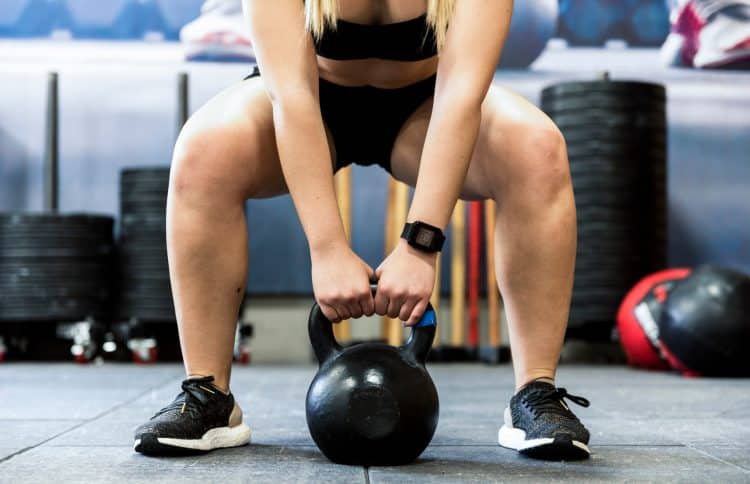
Kettlebells offer a range of benefits to people of all fitness levels. Including kettlebell movements in your training program can produce outstanding results whether you are an experienced athlete or are just beginning your fitness journey. Here are nine reasons to build your own DIY kettlebells:
- Full-Body Engagement: Kettlebells work several muscle groups simultaneously, improving overall strength and endurance.
- Functional Strength: Kettlebell training forges functional strength, leading to better performance in routine tasks like carrying groceries or playing with your children.
- Cardiovascular Conditioning: Kettlebell workouts often involve dynamic and explosive movements. The mix of strength and cardio exercise improves fitness and fat loss.
- Core Stability: Core stability is vital for many kettlebell workouts because it helps you stay balanced and in control. This emphasis on core stability promotes better posture and lowers the chance of injury.
- Increased Flexibility: Mobility and flexibility are increased by kettlebell exercises because they involve an extensive range of motion. This becomes increasingly important as we get older.
- Time Efficiency: Kettlebells deliver a lot of ‘bang for your buck,’ making them a time-efficient training tool. Kettlebells are effective if you only have a few minutes to train.
- Variety: Kettlebells are more versatile than dumbbells. You can do every dumbbell exercise, a range of swinging exercises, and unique moves like the Turkish get-up.
- Strengthens Your Grip: Kettlebell handles are thicker than dumbbells’. This will develop grip and forearm strength over time, translating to other exercises like deadlifts and pull-ups.
- Calorie Burn: Plenty of kettlebell exercises burn a ton of calories in a short time. Hard, short bursts of energy produce the EPOC effect, leading to increased metabolism for several hours after a workout.
Kettlebells vs. Dumbbells
Despite their widespread use, many gymgoers are still perplexed by kettlebells. They don’t see why anyone would use them because they can quickly grab a pair of more comfortable dumbbells. These are the top five reasons to choose kettlebells over dumbbells:
- Functional movement: A kettlebell’s unusual bell form and offset grip are ideal for dynamic exercises like kettlebell swings. Your entire body’s muscles and aerobic system can be worked with this design.
- Grip Strength: The heavier handle of a kettlebell makes you use your grip and forearms more, strengthening and increasing your forearm size.
- Core Activation: Because of its structure, a kettlebell is perfect for exercises that target the glutes, hips, and core.
- Cardio Training: There are many kettlebell exercises that both build muscle and work your heart. The repetitive explosive movements included in kettlebell swinging movements will get you puffing like a steam engine.
- Core Activation: A kettlebell’s offset center of gravity differs from a dumbbell, which is an essential distinction between the two weights. As a result, the kettlebell becomes unstable, requiring the core and stabilizing muscles to work harder. The Turkish get-up and kettlebell windmills are excellent exercises for engaging the core.
- Joint Mobility: Kettlebell exercises can enhance flexibility and joint mobility much better than dumbbell exercises.
Read more on Kettlebells vs. Dumbbells.
Level Up Your Fitness: Join our 💪 strong community in Fitness Volt Newsletter. Get daily inspiration, expert-backed workouts, nutrition tips, the latest in strength sports, and the support you need to reach your goals. Subscribe for free!
The Cost Barrier
Kettlebells are expensive. They are priced according to their weight and quality. Buying multiple kettlebells of different weights for progressive training can burn a hole in your wallet.
Here’s what you can expect to pay for store-bought kettlebells:
- Traditional cast iron kettlebells: $1-$2 per pound
- Vinyl-coated kettlebells: $1.50- $3 per pound
- Competition kettlebells: $2.50-$4 per pound
- Adjustable kettlebells: $100-$300
Kettlebell Basics
Kettlebells are available in various sizes and shapes to suit different training requirements. The traditional design comprises a flat base, a bell-like body, and a handle on top. The same weight and size across brands guarantee consistency.
Kettlebells range in weight from a few pounds to 100 pounds. The material utilized to build a kettlebell significantly impacts its quality. The following are the top three materials:
- Cast Iron: Kettlebells are typically made of cast iron. They are frequently painted to prevent rusting.
- Vinyl Coated: Cast iron that has been vinyl coated offers some degree of protection from dents and scratches. They also make less noise.
- Steel: Kettlebells made of steel have a smoother surface than those made of cast iron. Steel also enables more precise weight measurement.
5 DIY Kettlebell Ideas
Now that we’ve explored why you should add kettlebells to your workout, let’s discover how you can do so without breaking the bank. Here are our top 5 DIY kettlebell ideas:
1. Making a Traditional Kettlebell
By following these step-by-step DIY instructions, you can make a kettlebell with the same form and functionality as a store-bought version:
- Select a Mold: Purchase a kettlebell mold or construct one out of PVC pipe, a bucket, or another appropriate container (see instructions below).
- Choose Filling: To give your kettlebell the weight you want, choose fillers like sand, gravel, or concrete. Carefully measure the weight of the added filler so you end up with the kettlebell weight you want.
- Line the Mold: Use plastic wrap to prevent the filling from sticking.
- Pour the Filling: Fill the mold with the material of your choice, compacting it as you go.
- Let it Set: Leave the filling to dry and set. This can require a day or more.
- Remove From Mold: Carefully remove the filling from the mold once the filling has dried completely.
- Smooth and Seal: To minimize chipping or wear over time, smooth rough edges or surfaces.
Making a Kettlebell Mold:
Materials:
- PVC pipe (or bucket, container)
- Measuring tape or ruler
- Marker or pencil
- Saw (if using PVC pipe)
- Sandpaper (if using PVC pipe)
- Plastic wrap or releasing agent
- Duct tape or strong adhesive
Step-by-Step Guide:
- Choose whether the mold for your DIY kettlebell will be made from PVC tubing, a bucket, or another appropriate container.
- Measure the diameter and height of the kettlebell you want to replicate. The measurements will aid your choice of PVC pipe or container size.
- If you’re using PVC pipe, cut it to the required height using a saw. To smooth out the edges and avoid sharp ones, sand them using sandpaper.
- If you’re using a bucket or other container, ensure it’s dry and clean. If the container top is not already cylindrical, you might need to tape it to give it the proper kettlebell form.
- Line the interior of the container with plastic wrap.
Safety and Quality Assurance
Getting the right weight distribution in your DIY kettlebell is essential for proper balance. Poorly distributed filler results in instability and awkwardness that could lead to injury while training.
Ensure you thoroughly compact the filler to eliminate air pockets and ensure it is evenly spread. Occasionally, tap the mold with a hammer during the fill to help the filling set evenly.
Once it is filled, place the kettlebell on a flat surface to ensure it is balanced. Gently prod it from various angles, checking that it remains stable and balanced.
Regularly inspect your kettlebell for signs of wear and tear. We recommend applying a protective coating to help prevent chipping or other external damage.
Store your kettlebell in a cool, dry place to reduce the chance of rust or other damage.
2. The Tim Ferris T-Handle Kettlebell
Tim Ferris is the author of a series of best-selling fitness books, including ‘The Four Hour Workout,’ ‘The Four Hour Body,’ and ‘The Four Hour Chef.’ In ‘The Four Hour Body,’ Ferris describes a device he calls the ‘T-Handle’ Kettlebell, specifically designed for kettlebell swings. According to Tim, you can make it for just $11. Here’s how:
Materials:
- 1 x ¾ inch x 12-inch steel nipple (pipe with male threads on each end)
- 2 x ¾ inch by 5-inch steel nipples
- 1 x ¾ steel T-Joint
- Duct Tape
- 1 x ¾ steel floor flange
- Bolt clamp
Step-by-Step Guide:
- Begin by screwing the 12″ nipple securely into the floor flange with a wrench. Add duct tape around the join for extra strength.
- Attach the T-joint to the opposite end of the 12″ nipple.
- Screw the 5″ nipples onto either side of the T-joint. Ensure not to over-tighten this assembly because you’ll have to remove the handle to put the weight plates onto the device.
- Wrap duct tape around each side of the handle to provide a secure grip.
- Unscrew the handle from the T-joint and add weight plates to the 12” pipe.
- Secure the weights with a blot clamp.
- Test your Kettlebell by performing a few kettlebell swings.
3. Making a Kettlebell from a Milk Jug
Materials:
- Plastic milk jug (empty and cleaned)
- Water or sand (for adding weight)
- Duct tape or strong tape
- Handle material (optional, e.g., a sturdy wooden dowel or PVC pipe)
Step-by-Step Guide:
- Select a plastic milk jug that is in good condition. Thoroughly clean it to remove any residue.
- Choose your filling material. We suggest water or sand. Water is easier to fill and adjust, while sand makes the kettlebell more stable.
- Add a small amount of your chosen filling to the jug. Then, put on the cup and test the kettlebell to see how it feels. Keep filling until you reach a suitable weight level.
- Securely seal the cap once you’ve filled it to the desired level.
- Reinforce the Handle. You can secure your handle by wrapping duct tape around the jug handle.
- Test your milk jug kettlebell by giving it a few swings to ensure it feels right.
4. Converting a Dumbbell to a Kettlebell
You can convert a dumbbell into a usable kettlebell by making a few adjustments to give it the type of swing and dynamic movement you get with a kettlebell. Here’s how to do it:
Materials:
- Dumbbell
- Towel
- Duct tape
Step-by-Step Guide:
- Choose your dumbbell. Go with a weight that allows you to do at least 25 reps on the dumbbell bench press. If it’s any heavier than that, you will struggle to keep control of the kettlebell.
- Place your towel on the floor and then put the dumbbell next to one end of it in a horizontal position.
- Fold the towel over the dumbbell to make a handle, securely wrapping it around the weight.
- Wrap duct tape around the towel handle to keep it secure.
- Test your makeshift kettlebell by performing a few kettlebell swings. Check for balance and stability.
5. Making a Kettlebell from a Rubber Ball
Making a functioning kettlebell from a simple rubber ball can be interesting and satisfying. Here’s what you’ll need to do it.
Materials:
- 1 bag of pre-mixed Quikrete concrete mix
- Cheap rubber ball
- 26″ of 3/4″ or 1″ PVC pipe (sch40)
- Small quantity of sand
- Duct tape
- Water
- Hacksaw or Jig Saw
- Heat Gun or Oven
- Bucket
- Small Garden Spade or similar tool
- Pair of Scissors
Step-by-Step Guide:
Preparing the Handle:
- Use a hacksaw to trim the PVC pipe to 26″.
- Cover one end of the PVC with duct tape.
- Sand should be put into the PVC pipe, and the other end should be taped shut.
- Heat the PVC using a heat gun or an oven.
- Form the PVC into a triangle with rounded corners by hand or with a template.
- Reheat and reshape as necessary.
- Submerge the PVC in cool water to speed up cooling.
- Ensure the handle’s length is correct before cutting a split into the rubber ball.
- Make two circles at either end of the slit to fit the PVC.
- Pour Quikrete into a bucket and gradually add water to make a thick paste.
- Fill the rubber ball with the concrete mixture, pressing down to make a dent at the bottom.
- Insert the PVC handle to a comfortable depth.
- Fill the ball with concrete, tapping it to settle the mixture.
- Ensure the handle is straight and at the desired depth.
- Wipe off excess concrete and let it set for 24 hours.
- After setting, wipe the kettlebell again, and it’s ready for use.
Customizing Your Home-Made Kettlebells
There are several ways to personalize and enhance the functionality of your DIY kettlebells. Here are six ways to give your homemade weights a personal touch.
Level Up Your Fitness: Join our 💪 strong community in Fitness Volt Newsletter. Get daily inspiration, expert-backed workouts, nutrition tips, the latest in strength sports, and the support you need to reach your goals. Subscribe for free!
- Investigating Filling Options: One of the appealing features of homemade kettlebells is the flexibility to change their weight to suit your fitness level. Although sand, gravel, and concrete are typical filling materials, you should look into alternate choices that fit your preferences and the desired outcomes. For instance, employing water as a filler makes it easier to change the weight by including or excluding the liquid. A fun workout can also result from experimenting with novel fillers like dry beans, steel shot, or rice.
- Different Styles of Handle Wrapping: Your kettlebell’s handle is crucial for a secure grasp and a cozy hold. To elevate your kettlebell handle, look into inventive wrapping techniques that increase grip. Instead of standard duct tape, consider using paracord, colorful sports tape, or textured grip tape. These materials improve your kettlebell’s grip while adding a personalized touch that reflects your taste.
- Designing Individualised Kettlebell Shapes: While traditional kettlebells have a bell-like shape, you can utilize your creativity to design a special kettlebell. Consider experimenting with several designs that offer ergonomic advantages and a selection of workout possibilities. For instance, creating a kettlebell with many gripping points or asymmetrical handles might give your workouts new obstacles. You can also have a more ergonomic grip for a range of exercises by using curves and contours in the design of your kettlebell.
- Including Decorative Elements: Making your kettlebell into a work of practical art is another intriguing modification idea. Look into adding decorative elements that fit your distinct taste. Use stencils and spray paint to add patterns or designs to the kettlebell’s exterior. Do not let any ornaments compromise the security or usage of the kettlebell.
- Making Your Homemade Kettlebell Weight Adjustable: Making a modular kettlebell system that allows you to add or remove weight plates as needed will allow you to change the intensity of your workouts.
No matter what personalization decisions you make, safety and durability should always come first. Check your kettlebell frequently to ensure it’s in good shape. Ensure that any alterations you make don’t impair the kettlebell’s safety or undermine its structural integrity.
Getting the Most From Your DIY Kettlebells — 6 Workouts
Having gone to the effort to make your own kettlebells, you must ensure you get the most benefit out of them. Here are seven different types of home-based kettlebell workouts, each one designed to challenge your body uniquely:
1. Full-Body Kettlebell Circuit
A circuit involves switching from one exercise to the next without taking a break. It challenges your cardiovascular system and tones your muscles. Aim for 12 to 15 reps per exercise.
Take a minute to recover after completing the circuit. Aim for three rounds of the circuit.
Sample Workout:
Kettlebell Swing:
Stand with your feet hip-width apart while holding the kettlebell in both hands. Knees should be slightly bent, and hips should be hinged.
Swing the kettlebell back slightly between your knees to build momentum and then explosively up to shoulder height.
Allow the bell to swing back down between your legs.
Complete 20 to 30 swings.
Kettlebell Rows:
- Stand with feet shoulder-width apart and a kettlebell held in your right hand.
- Hinge at the hips and bend your knees slightly as you lean your torso to a 45-degree angle.
- Maintain a neutral spine and keep your chest up as you pull the weight toward your body.
- Lower and repeat.
- Do 12 reps on each side.
Kettlebell Push Press:
- Hold the kettlebell at shoulder height in one hand.
- Bend your knees slightly and explosively push the kettlebell overhead.
- Lower it back to shoulder height. Perform 10-12 reps on each side.
Kettlebell Russian Twists:
- Sit on the floor with your knees bent and feet elevated off the ground.
- Hold the kettlebell with both hands close to your chest. Lean back slightly and twist your torso to one side, then the other.
- Perform 15-20 twists on each side.
Kettlebell Plank Drags:
- Get into a push-up position with a kettlebell placed on your side.
- Reach under your body with the opposite hand to drag the kettlebell to the other side. Keep your core engaged and hips stable.
- Perform 10-12 drags on each side.
2. Cardio-Boosting Tabata Workout
Tabata training entails quick bursts of high intensity followed by short recovery periods. You may create a Tabata kettlebell workout by picking two movements, such as kettlebell swings and burpees.
Perform an all-out effort on the first exercise for 20 seconds. Follow this with a 10-second recovery. Alternate between the all-out effort and rest duration for four minutes. Aim for 3 to 4 rounds and rest between each one for a minute or two.
Sample Workout:
Go all-out for 20 seconds on each exercise, then take a 10-second recovery break. Do each exercise eight times and then move to the next one, allowing a one-minute rest between them:
Kettlebell Swing:
- Hold the kettlebell with both hands and stand with your feet hip-width apart.
- Bend your knees slightly and hinge at your hips.
- Swing the kettlebell between your legs and then explosively swing it up to shoulder level.
- Use the momentum generated by your hips and legs.
- Perform 20 seconds of swings, followed by 10 seconds of rest.
Kettlebell High Knees:
- Hold a single kettlebell by the handle with both hands at chest height.
- Perform high knees while simultaneously swinging the kettlebell up and down.
- Focus on bringing your knees up as high as possible.
- Perform 20 seconds of high knees with kettlebell, followed by 10 seconds of rest.
Kettlebell Mountain Climbers:
- Place a pair of kettlebells on the floor, shoulder distance apart.
- Get down on the floor, grab the kettlebell handles, and then assume the top push-up position.
- Alternate bringing your knees toward your chest in a running motion.
- Keep your core engaged and maintain a steady pace.
- Perform 20 seconds of kettlebell mountain climbers, followed by 10 seconds of rest.
Kettlebell Burpees:
- Stand with your feet shoulder-width apart and a kettlebell held, with both hands on the horns, in front of your body.
- Hinge at the hips and bend your knees to bring the kettlebell to the floor horizontally. Your knuckles should touch the floor.
- Jump your legs back to assume a push-up position.
- Explosively jump up, lifting the kettlebell overhead.
- Perform 20 seconds of kettlebell burpees, followed by 10 seconds of rest.
3. Core-Strengthening Superset
Focus on your core muscles with a superset using kettlebells that blend dynamic movements and isometric holds. Try movements like plank rows, kettlebell windmills, and Turkish get-ups. Alternate between dynamic exercises and isometric holds to put your core through various challenges. Each superset should be performed three to four times, with perfect form and control.
Sample Workout:
The exercises in each superset should be performed with little rest in between. After the superset, take a 20-second break. Repeat for 3-4 rounds.
Superset 1: Kettlebell Windmills and Turkish Get-Ups Right Side
Kettlebell Turkish Get-Ups:
- Lie on your back with a kettlebell in your raised right arm. Place your left arm out to the side and your right knee bent.
- Push yourself up onto your left elbow and then onto your left hand.
- Get into a kneeling position by raising your hips off the floor.
- Kettlebell held overhead as you stand up.
- To get back to where you started, reverse the motion.
- Do 5 repetitions on each side.
Kettlebell Windmills:
- Stand with your feet a little wider than shoulder width and a kettlebell held at arm’s length overhead with your right hand.
- Bend your torso to the left to lower your left hand toward the floor.
- Return to the start position and then repeat on the right side.
- Do 10 reps per side.
Superset Two: Kettlebell Russian Twists with Kettlebell Renegade Row
Kettlebell Renegade Row:
- Put both hands on a kettlebell handle and assume the push-up position.
- As you balance on your left side, row the right kettlebell towards your hip.
- Lower to the floor and repeat with the left kettlebell.
- Do 12 reps per side.
Kettlebell Russian Twist:
- Get down on the floor with your knees bent and feet slightly elevated. Hold a kettlebell in both hands over your chest.
- Rotate your torso to the left as you bring the kettlebell down to the floor.
- Return to the start position and then repeat on the right side.
- Do 15 twists per side.
4. Kettlebell Lower Body Workout
Focus on developing lower body strength and stamina. Include kettlebell step-ups, deadlifts, lunges, and goblet squats in your routine. To complete 3–4 sets, perform each exercise 10–12 times on each leg.
Sample Workout:
Kettlebell Goblet Squat:
- Hold the kettlebell close to your chest with both hands.
- Stand with your feet shoulder-width apart.
- Lower yourself into a squat, keeping your chest up and back straight.
- Push through your heels to return to the starting position.
- Perform 3 sets of 12-15 reps.
Kettlebell Romanian Deadlift:
- Hold the kettlebell with both hands in front of your thighs.
- Stand with your feet hip-width apart and a slight bend in your knees.
- Hinge at your hips while keeping your back straight and lower the kettlebell toward the ground.
- Lower the kettlebell as far as your flexibility allows while maintaining good form.
- Return to the starting position while contracting your glutes and extending your hips.
- Perform 3 sets of 10-12 reps.
Kettlebell Bulgarian Split Squat:
- Stand facing away from a bench or elevated surface with a kettlebell in one hand.
- Place one foot on the bench behind you.
- Lower your body into a lunge, keeping your front knee above your ankle.
- Push through your front heel to return to the starting position.
- Perform 3 sets of 10-12 reps per leg.
Kettlebell Step-Up:
- Hold a kettlebell in one hand by your side.
- Stand in front of a bench or step.
- Step up onto the bench with one leg, driving through your heel.
- Fully extend your hip and knee at the top of the movement.
- Lower yourself back down under control.
- Perform 3 sets of 10-12 reps per leg.
Kettlebell Swings:
- Hold the kettlebell with both hands and stand with your feet hip-width apart.
- Bend your knees slightly and hinge at your hips.
- Swing the kettlebell between your legs and then explosively swing it up to shoulder level.
- Use the momentum generated by your hips and legs.
- Perform 3 sets of 15-20 swings.
5. Complexes to Build Endurance
Complexes involve doing a sequence of exercises without putting the kettlebell down. Make up your own complex by choosing four to five movements, such as kettlebell swings, cleans, presses, squats, and rows.
Sample Workout:
Perform each exercise for 8-10 repetitions with minimal rest between exercises. Complete the entire complex for 3-4 rounds. Rest for 1-2 minutes between rounds.
Kettlebell Goblet Squat:
- Hold the kettlebell close to your chest with both hands.
- Perform a squat, keeping your chest up and back straight.
- Push through your heels to return to the starting position.
Kettlebell Push Press:
- Hold the kettlebell in one hand at shoulder height.
- Bend your knees slightly and explosively press the kettlebell overhead.
- Lower it back to the shoulder.
Kettlebell Bent-Over Row:
- Hold the kettlebell with one hand and hinge at your hips to bend forward.
- Perform rows by pulling the kettlebell toward your hip.
- Lower the kettlebell back to the ground.
Kettlebell Deadlift:
- Hold the kettlebell with both hands between your legs.
- Stand up straight while keeping your back flat.
- Hinge at your hips to lower the kettlebell to the ground.
- Stand up tall to complete one repetition.
6. Active Recovery and Mobility Flow
Use your home-made kettlebells as part of an active recovery and mobility regimen. To increase shoulder mobility and stability, perform workouts such as kettlebell halos, figure-eight passes, and around-the-worlds. Combine these motions with dynamic mobility drills and stretches to improve flexibility and joint health.
Sample Workout:
Perform each exercise slowly and with controlled movements. Focus on your breathing and mobility throughout the routine. Perform each exercise for 45-60 seconds or a specified number of repetitions.
Kettlebell Hip Bridges:
- Lie on your back with your knees bent and feet flat on the ground.
- Place a kettlebell on your hips.
- Lift your hips off the ground, pushing through your heels.
- Squeeze your glutes at the top.
- Lower your hips back down.
- Perform 12-15 reps.
Kettlebell Halo:
- Hold the kettlebell upside down by the horns.
- Stand with your feet hip-width apart.
- Circle the kettlebell around your head in one direction.
- Switch direction after 30 seconds.
Kettlebell Figure 8s:
- Stand with your feet shoulder-width apart.
- Pass the kettlebell through your legs in a figure-eight motion.
- Keep your core engaged and your back straight.
- Perform for 45-60 seconds.
Kettlebell Prying Goblet Squat:
- Hold the kettlebell close to your chest with both hands.
- Perform a deep goblet squat, pushing your elbows against your knees to open up your hips.
- Hold the bottom position for a few seconds.
- Repeat for 45-60 seconds.
Kettlebell Windmill Stretch:
- Hold the kettlebell in one hand and extend your arm overhead.
- Stand with your feet wider than shoulder-width apart.
- Hinge at your hips and bend to one side, keeping your arm extended.
- Return to the starting position and switch sides.
- Perform for 45-60 seconds.
Kettlebell Arm Circles:
- Hold the kettlebells out to the sides at arm’s length.
- Perform slow, controlled circles with your arm, moving through the full range of motion.
- Switch directions after 30 seconds.
Kettlebell Cossack Squat:
- Hold the kettlebell with both hands close to your chest.
- Stand with your feet wide apart.
- Lower your body to one side while keeping the opposite leg straight.
- Alternate sides for 45-60 seconds.
Prioritize good form when exercising, warm up properly before each workout, and cool down properly afterward. As your strength and fitness improve, gradually increase the intensity and complexity of your workouts.
More DIY:
- Forget Commercial Protein Bars — 6 Homemade Protein Snacks for Cleaner Eating and Better Nutrition
- Fitness on a Budget: Affordable Ways to Stay Fit in the New Year
- DIY Dumbbells — 6 Sturdy, Homemade Weight Ideas For Any Workout
- How To Clean Horse Stall Mats in Home Gyms
- 6 DIY Homemade Weight Bench Ideas – The Ultimate Guide
- 6 DIY Weight Plate Storage Ideas For Your Home Gym
- 7 Easy DIY Barbell Holder Ideas For Your Home Gym
- 15 Best Homemade Gym Equipment For Your New Garage Gym
Conclusion
You don’t have to go into financial debt to enjoy the benefits of kettlebell training. In this article, we’ve outlined five different methods to create your own DIY kettlebells for a fraction of the cost of buying them from a store. You don’t have to be a DIY maestro to tackle these tasks, either. They are all relatively straightforward projects.
Select the method that appeals to you the most, gather the materials, and make it happen. Then, put your DIY kettlebell into action with one of our sample workouts. Let us know in the comments below which DIY method you used and how challenging you found the workout.
More on Kettlebells:
- The Ultimate Guide to Buying Kettlebell Weights
- No Frills Fitness: One Kettlebell and Bodyweight Full-Body Workout
- Kettlebell Workouts for Functional Fitness
- 15 Best Kettlebell Core Exercises and Workout for Stronger Abs
- Upper Body Kettlebell Exercises + Workouts
- The Ultimate Guide to Buying Kettlebell Weights
- 16 Different Types of Weights Used in Gyms
- 13 Advantages of Doing 100 Kettlebell Swings a Day

